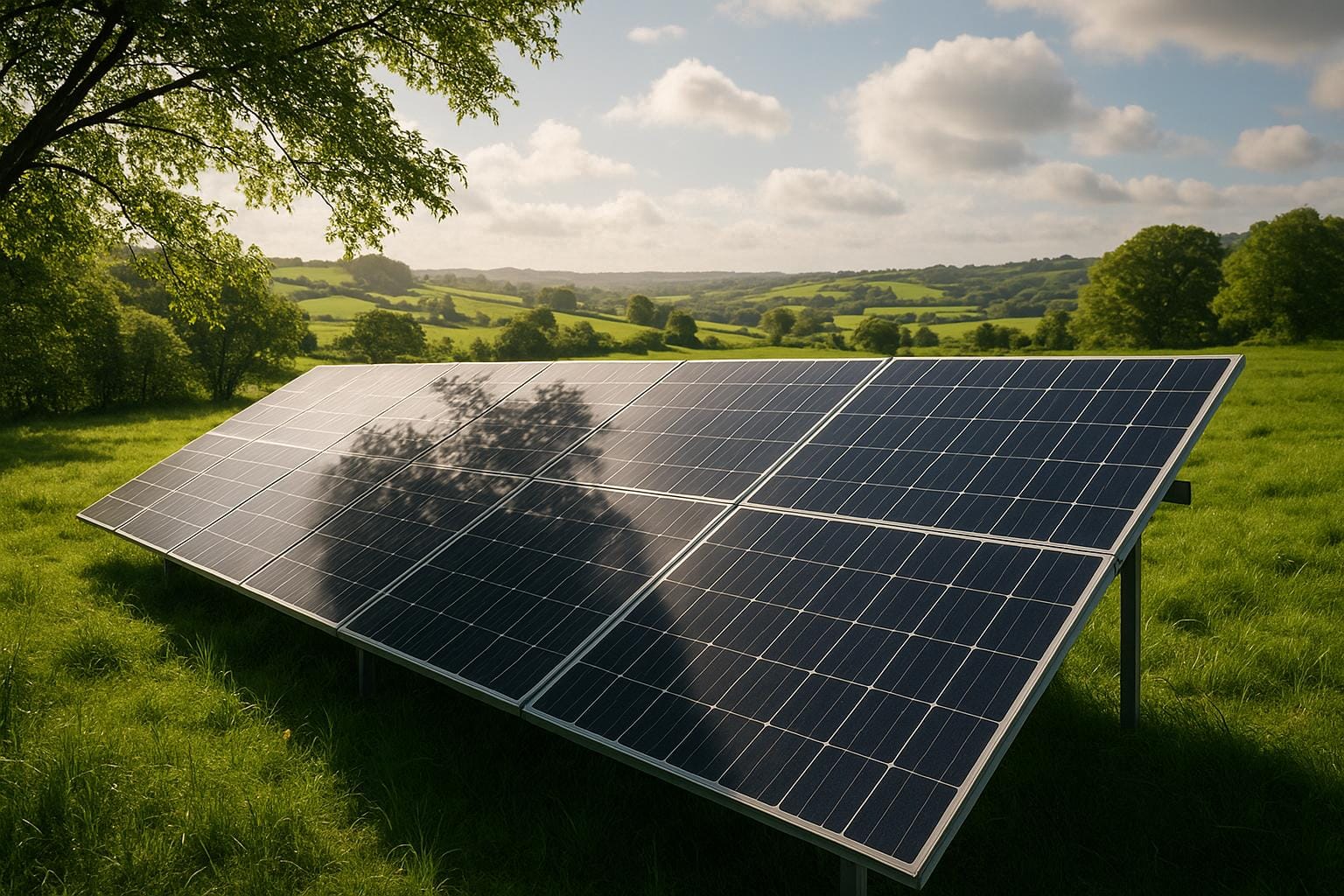How Shading Affects Solar Panel Efficiency
Learn how shading impacts solar panel efficiency in Ireland and discover strategies to maximize energy production despite environmental challenges.

Shading can significantly reduce the efficiency of solar panels. Here’s what you need to know:
- Even small shading can cause big losses: Shading just one cell in a panel can reduce its output by 50–80%. In a string of panels, a 10% shaded area on one panel could cut the system's output by half.
- Ireland’s climate makes shading worse: Long shadows, frequent cloud cover, and rain mean that shading is a common challenge for Irish solar systems.
- Common causes of shading: Trees, nearby buildings, roof features like chimneys, and even debris like leaves or snow can block sunlight and reduce energy production.
- Solutions to reduce shading impact:
- Smart placement: Position panels to avoid obstructions, ideally facing south at a tilt of 30–40°.
- Use micro-inverters or power optimizers: These technologies allow each panel to work independently, minimizing losses.
- Maintenance: Regular cleaning and trimming nearby trees can keep panels performing well.
I tested 20 different shading scenarios on Solar Panels! How does shade affect solar panels?
How Shading Reduces Solar Panel Performance
Solar panels rely on series-connected cells, which means even a single shaded cell can drastically limit the output of the entire panel.
The Shading Line Effect
When one cell in a string is shaded, it restricts the flow of current through the entire string. Back in 2004, Gil Masters from Stanford University demonstrated just how severe this effect can be. His research showed that shading a single cell out of 36 in a small solar module could slash the total power output by up to 75%. This issue becomes even more pronounced in regions with challenging climates, like Ireland.
Shading Problems in Ireland's Climate
Ireland’s geographic location and weather patterns make shading a significant concern for solar panel systems. Because of its high latitude, the sun sits lower in the sky, creating longer shadows that can stretch across rooftops and solar arrays. On top of that, sunshine is a rare commodity - Ireland averages only 3.8 hours of sunlight per day. Frequent cloud cover results in "soft shading", where light levels are uniformly reduced. Add in the region’s consistent rainfall and sudden weather changes, and the challenges only grow.
Joe Brennan, Founder of Going Solar, sheds light on the situation:
"Ireland's weather, heavily influenced by its proximity to the Atlantic Ocean, is characterized by mild temperatures, frequent rainfall, and unpredictable shifts in conditions throughout the year."
Given these conditions, making the most of every moment of clear skies is essential. Additional shading from nearby trees, buildings, or other obstacles can further limit the already scarce solar resource. Irish studies confirm that these conditions have a significant impact on solar panel efficiency.
Data on Shading Impact
Research in Ireland has found that shading can reduce solar panel output by as much as 50%. The type of shading plays a big role in determining the extent of the loss. Hard shading from objects like trees, chimneys, poles, or even accumulated dust, snow, or leaves causes the most severe drops in performance. Even small obstructions can create a cascading effect, leading to substantial power losses across an entire string of panels.
In systems with multiple panels connected in series, output losses can soar beyond 75%. This happens because when one module is shaded, it limits the power output of the entire string - not just the single affected panel.
For homeowners, even a modest reduction in annual energy production can have a noticeable impact on their system’s return on investment and payback period. Every bit of lost efficiency adds up, making shading a critical factor to address when planning and maintaining solar installations.
Common Causes of Shading in Irish Solar Installations
Shading is a major factor that can impact the efficiency of solar panels, especially in Ireland, where unique environmental and structural factors come into play. Understanding these causes can guide homeowners and businesses in optimizing panel placement and system design. Let’s explore the main culprits behind shading in Irish solar installations.
Trees and Vegetation
Trees are a common source of shading, and their impact can vary depending on the type. Evergreen trees create consistent, year-round shadows, while deciduous trees bring seasonal fluctuations that can catch system owners off guard. Even a single large tree located to the south of a solar array can drastically cut energy output. Overgrown hedgerows and tall shrubs pose similar risks, particularly in smaller residential properties where limited space often forces panels closer to boundaries.
Nearby Buildings and Structures
Urban and suburban areas frequently deal with shading caused by surrounding buildings and architectural features. Chimneys, dormer windows, and roof-mounted equipment like satellite dishes can cast shadows on solar panels, especially during mornings and evenings when the sun sits lower in the sky. In residential neighborhoods, houses to the south can block sunlight, a problem made worse by Ireland’s high latitude, which results in longer shadows throughout the year.
For commercial setups, the challenges increase with larger structures like industrial buildings, water towers, and telecommunications equipment. A good example is a school in County Cork that installed a 50kW solar system producing up to 44,000 kWh annually. The success of this system relied heavily on thoughtful planning to work around the school’s existing structures. Even walls and fences can contribute to shading, creating ripple effects that can reduce the performance of entire strings of panels.
Seasonal and Daily Sun Angle Changes
Shading isn’t just about fixed obstacles - it’s also influenced by how the sun moves throughout the day and year. Ireland’s high latitude means the sun follows a much lower path in the sky during winter, leading to longer shadows. This can turn objects that seem harmless in summer into significant obstructions during colder months, when energy needs are often at their peak. The stark difference in daylight hours between seasons makes every bit of sunlight count.
On a daily basis, the shifting sun angle creates dynamic shading patterns. For instance, a chimney might shade panels on the east side of a roof in the morning and then affect those on the west side later in the day. The lower sun angle throughout the year also means that even relatively small objects can cast surprisingly long shadows. Adding to this, Ireland’s frequent cloud cover can create soft shading, further reducing the amount of direct sunlight reaching the panels. This makes it critical to design systems that maximize exposure to direct sunlight as much as possible.
Solutions to Reduce Shading and Improve Solar Performance
Boosting solar panel efficiency in shaded conditions requires a mix of thoughtful planning and cutting-edge technology. These approaches ensure panels are positioned and equipped for peak performance.
Smart Placement and Positioning
Proper placement starts with careful planning. Using shading analysis tools during the design phase helps identify potential issues. Panels should ideally face south to maximize energy output. As Briain Kelly points out:
"In Ireland, south facing solar panels will provide the most electricity throughout the day. This is because here in the Northern Hemisphere, the sun is to the south of us."
East–west orientations produce about 20% less energy, while north-facing panels are generally ineffective. The optimal tilt angle in Ireland falls between 30° and 40° from horizontal, ensuring strong year-round performance. Placing panels in areas free from obstructions like trees or buildings can make a significant difference, as shading can reduce power output by over 75%. Even minor adjustments can lead to noticeable improvements in energy generation.
Micro-Inverters and Power Optimizers
In traditional string-connected systems, a single shaded panel can drag down the performance of the entire string. Micro-inverters and power optimizers solve this problem by allowing each panel to function independently, maximizing overall output. Homes equipped with micro-inverters have reported a 5–10% increase in energy production in areas prone to shading. Power optimizers, on the other hand, manage voltage and current at the panel level, isolating the effects of shading. These devices have shown efficiency gains of about 5% under partially shaded conditions.
When deciding between the two, micro-inverters are ideal for roofs with complex layouts or intermittent shading, while power optimizers are a more budget-friendly option. Both are reliable, with failure rates of approximately 1 in 1,500 for micro-inverters and 1 in 1,300 for power optimizers.
Smart Modules and Monitoring Systems
Advanced systems now use real-time monitoring and optimization technologies to handle shading challenges. Module-Level Power Electronics (MLPEs), such as micro-inverters and DC optimizers, enable maximum power point tracking at the individual panel level, reducing shading losses. For example, a test in Palo Alto, California, showed a 17.3% annual increase in output for a home with tall trees when MLPEs replaced a standard string inverter.
Smart monitoring systems also track shading patterns, using data to provide insights into how shadows impact energy production throughout the day and year. For homes dealing with dynamic shading, dual-axis tracking systems can boost energy output by up to 40% compared to fixed panels, while single-axis trackers can improve production by up to 25%. Although these systems involve higher upfront costs, they can maximize energy generation in limited spaces. Addressing shading is critical, as shadows can reduce a household's solar energy potential by as much as 40%. Regular cleaning, often prompted by smart system alerts, further ensures peak performance.
Conclusion: Improving Solar Panel Performance in Shaded Areas
Shading doesn’t have to derail the efficiency of your solar panels. While shadows can limit energy production, combining thoughtful planning, advanced technology, and consistent maintenance can significantly reduce these losses.
The first step is strategic placement. A detailed shading analysis before installation helps pinpoint obstructions and ensures panels are positioned for maximum exposure to sunlight. South-facing panels generally perform best, while east or west orientations may produce up to 40% less energy due to fewer sunlit hours. Proper positioning sets the stage for a more efficient solar system.
When ideal placement isn’t possible, modern technology steps in. Tools like micro-inverters and power optimizers can improve energy output by 5–10% in partially shaded conditions, making them a valuable addition to any system.
Finally, routine maintenance plays a key role in keeping your panels performing well. Professional cleanings can boost energy production by as much as 15%, while trimming nearby trees or removing debris ensures your panels stay clear of unnecessary shade.
For Irish homeowners, Get Solar Panels offers expert support, from detailed shading analyses to advanced system monitoring. Even in less-than-perfect conditions, these strategies can help your solar panels deliver strong, reliable performance.
FAQs
How do I choose the best location for solar panels to avoid shading?
To get the most out of your solar panels and tackle shading challenges effectively, keep these important tips in mind:
- Optimal Positioning: Install your panels on a south-facing surface whenever possible. This direction typically captures the most sunlight throughout the day. If south-facing isn’t an option, east or west-facing surfaces can still work. However, steer clear of north-facing areas, as they get the least sunlight.
- Shading Check: Look out for anything that might block sunlight, like trees, nearby buildings, or chimneys. Even a small amount of shading during peak sunlight hours can noticeably cut down your panels' energy production.
- Smart Technology Solutions: Consider adding tools like microinverters or power optimizers to your system. These devices help each panel work independently, so shading on one doesn’t drag down the performance of the others.
By picking the right spot and leveraging advanced tools, you can keep your solar panels running at their best, even when conditions aren't perfect.
What are the benefits of using micro-inverters or power optimizers in a solar panel system?
Micro-inverters and power optimizers play a key role in getting the most out of solar panel systems by letting each panel operate independently. This setup ensures that if one panel is shaded or not performing well, it won't drag down the output of the others.
Micro-inverters handle the job of converting DC (direct current) to AC (alternating current) right at the panel level. This not only boosts safety but also keeps performance steady, even when some panels face shading. On average, this setup can increase energy output by 5–10% compared to traditional systems.
Power optimizers, on the other hand, work alongside a central inverter. They manage voltage regulation at each panel, leading to about a 5% improvement in performance under similar conditions.
These technologies are particularly effective for setups where shading is an issue or panels are installed at varying angles, ensuring a more dependable and efficient energy production process.
How does Ireland's weather influence solar panel efficiency?
Ireland’s weather, marked by mild temperatures and frequent cloud cover, has a distinct impact on solar panel performance. On cloudy days, solar panels operate at about 10%–25% of their maximum efficiency. However, thanks to the country’s long daylight hours during the summer, they still produce energy consistently. Over the course of a year, Ireland receives approximately 1,100 to 1,300 kilowatt-hours (kWh) of solar radiation per square meter. While this isn’t as much sunlight as sunnier regions enjoy, it still makes solar energy a practical and worthwhile option.
What’s surprising is how Ireland’s cooler climate can actually enhance solar panel efficiency. In hotter regions, high temperatures can decrease the output of solar panels. But Ireland’s mild weather helps prevent overheating, allowing the panels to maintain steady performance. Plus, modern solar panels are designed to work well with diffused light, ensuring energy production even on overcast days. This combination of technology and climate makes solar panels a reliable and effective energy solution for Ireland.

